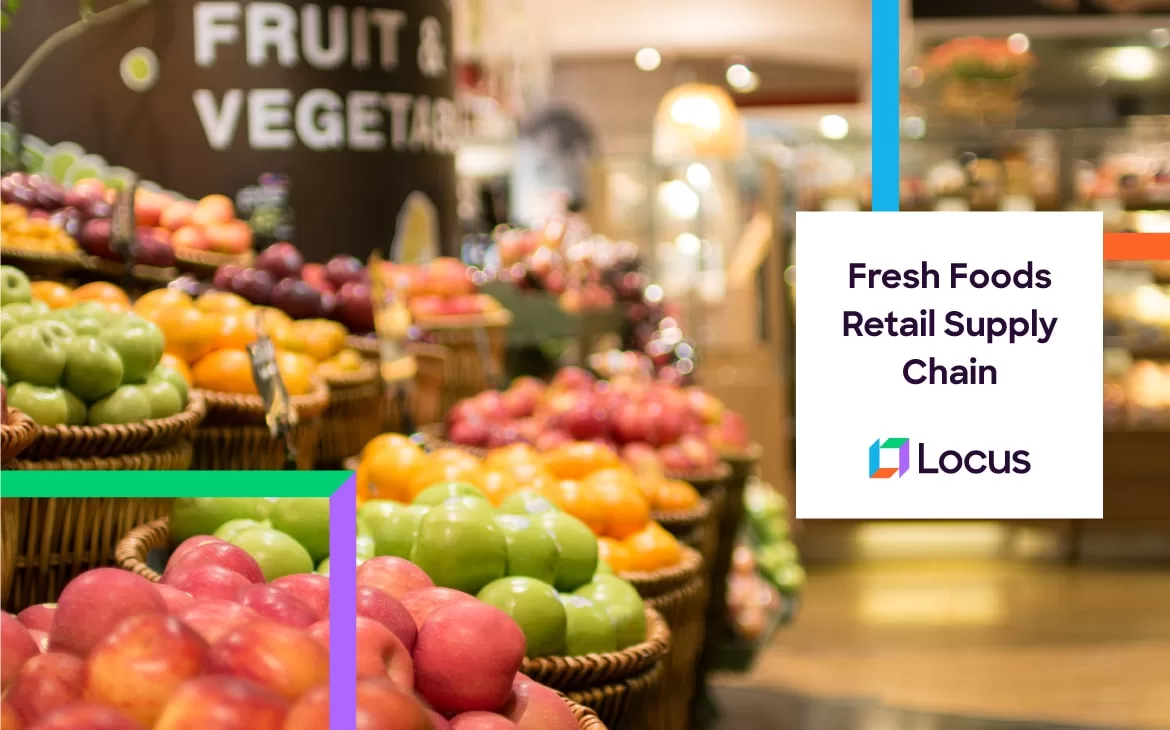Retail & CPG, Supply Chain Optimization
The Logistics of Fresh Foods Retail Supply Chain in 2022 and Beyond
Dec 2, 2020
7 mins read

Updated: May 13, 2022
Two years ago, the Coronavirus crisis redefined consumer shopping habits and established some new trends in retail and consumer goods markets. Stockpiling of essentials, online shopping for consumer goods, and convenient contactless deliveries were some of the most talked-about topics.
One of the biggest trends seen in the retail market that year was the growing demand for fresh foods—fruits and vegetables, meat, seafood, fish, dairy, baked goods, deli products, and more. In fact, the fresh food market size is estimated to grow by 337.76 million tons from 2019 to 2024, and the market’s growth is anticipated to accelerate at a compound annual growth rate (CAGR) of 3%.
According to a Deloitte report, fresh food sales are an important growth driver for retailers and a priority for shoppers who want to ensure they have ample fresh food at hand. Sales of fresh produce were up $4.5 billion between January and August 2020, compared to the same period in 2019. In terms of consumer preferences, fresh foods were more valued than ever; nine in 10 respondents said fresh food made them happy.

Demand For Fresh Food Persists
A year later, the demand for fresh food hasn’t cooled down yet. A 2021 survey says that 60% of contemporary consumers—younger families and more well-off and urban dwellers—say they recently increased their purchases of fresh food, up 10 percentage points from 2020. Further, 71% of contemporary consumers value the fresh brand, and 78% were willing to pay a premium for fresh food.
The availability of fresh foods is a key driver of in-store traffic in supermarkets and convenience stores. The most important attributes shoppers say when selecting their primary stores include high-quality fruits and vegetables—80%; high-quality meat—77%; and fresh food deli—53%.
Download the E-book – Food Delivery: The Past, Present, and Future
A number of fresh foods startups have sprung up since the onset of the pandemic that has been getting investor attention and growing in popularity among consumers. Impossible Foods, Memphis Meats, Nature’s Fynd, Alpha Foods, and Kate Farms were some of the top fresh foods startups of 2020 in the United States. In India too, there has been a spike in sales and investor interest for businesses in the fresh food space such as FreshToHome, Country Delight, Gourmet Garden, and Licious. With the increasing adoption of healthy food habits among young and old alike, these and several other fresh food businesses have seen steady growth since.
The Big Challenges in Fresh Food Supply Chains
While health-conscious consumers will always keep the demand for fresh food high, spoilage remains one of the biggest threats to fresh food supply chains. But maintaining freshness is only the tip of the iceberg. It sets a series of challenges for the supply chain that need to be met effectively. Some of these challenges are listed below:
1. Suboptimal Sourcing
While the fresh foods market is soaring, it is also one of the most complex supply chains to manage. The perishable nature of fresh produce makes their storage, transportation, and shelf-management a tightrope walk for fresh foods retailers.
Many retailers approach the procurement of fresh foods unsystematically and thus end up paying above-market prices. Retailers need to source fresh produce strategically, keeping in mind seasonal demand fluctuations, supplier costs, as well as supplier location.
Every supplier relationship should be based on the product’s supply, volatility in quality and volume. Products with high supply volatility are best sourced through stable suppliers, whereas products that are less volatile can be sourced through transactional or even spot-market purchasing, which allows retailers to respond to changes in demand.
2. Maintaining Freshness and Quality
From the minute that meat is butchered, eggs are laid, milk is packaged, fruit and vegetables are harvested and a loaf of bread leaves the oven, the freshness and quality of fresh foods are at risk. It is important to keep fresh foods at the right temperature and humidity levels throughout the supply chain. Fruits like oranges, grapes, and cherries need a temperature range of 0 to 2 degrees Celsius and 95% to 100% humidity. On the other hand, items like garlic and onions must be stored at a similar temperature but at humidity levels from 65% to 75%, as high humidity harms them.
Other products like bananas, avocados, and mangoes can be damaged by the cold and must be kept in the range of 13 to 15 degrees Celsius and between 85% to 90% humidity. Meat, poultry and dairy, and produce such as eggs, milk, yogurt, and cheese need cold storage facilities. The storage and transportation of these temperature and time-sensitive fresh foods is difficult compared to other durable products.
3. Packaging, Shipment, and Transportation Challenges
Fresh foods come in a variety of types, and must be packaged and shipped according to their durability and nature. Fresh produce such as apples, pineapples, pears, watermelons, or onions can be easily packaged into wooden trays. Foods such as tomatoes, eggs, softer fruits, and leafy vegetables, on the other hand must be packaged and handled carefully.
Once these foods are packaged, they must be shipped in ideal carriages, keeping in mind that some foods cannot be shipped together, while others can travel longer, or need fast transportation, or need cold storage. Delays in transit can significantly reduce the available shelf life of fresh produce in stores which can be off-putting to customers and a waste for retailers.
4. Lack of Visibility in the Supply Chain
Did you know? Supermarkets throw away 43 billion pounds of unsold food every year that has gone stale. Almost 30% of high-quality fruits and vegetables fall through the grid of trade chains and large supermarket chains only because of optical flaws. Lack of supply chain visibility is one of the biggest logistical challenges in fresh foods retail.
Due to this, retailers and logistics managers are unable to take preventive measures to salvage fresh produce when there is a delay in transportation or temperature instability at any point. Lack of visibility also leads to poor communication between sellers and retailers and between retailers and customers.
Logistics Tech Can Optimize the Fresh Foods Supply Chain
Digitization of the fresh food supply chain is a must, now more than ever, due to the rising demand for safe, contactless, same-day deliveries and intense competition in the market. Despite the serious challenges in the storage, shipment and logistics of perishable produce, the gaps in the fresh food supply chain can be filled with the help of logistics technology.
Technology such as Route Optimization can help retailers plan order dispatches and last-mile deliveries efficiently. Real-time visibility tools can help logistics managers be on top of distribution and on-ground operations.
With the help of AI-driven logistics planning, businesses can manage their delivery operations with ease. Locus’ real-world ready dispatch management platform helps with timely order scheduling, resource allocation, and route optimization making last-mile planning fast and efficient. Locus’ live visibility tool helps track orders in real-time and provide live status updates to customers, improving supply chain visibility and keeping customers satisfied.
By implementing AI-driven logistics solutions, brands can optimize every element in the fresh food supply chain; right from strategic sourcing, optimal storage, precise packaging and shipment in the right containers, to fast and efficient transportation.
Now stay ahead of the intensifying competition in the fresh foods retail market with Locus’ AI-enabled logistics. Get in touch with our experts for a quick tour of our solutions.

Related Tags:

E-Commerce
How to Overcome the Supply Chain Challenges in Direct-to-Consumer Selling
The growing demand for online shopping and convenient deliveries due to the pandemic has brought about a new revolution in the consumer goods and retail supply chain. While traditional mom-and-pop storekeepers have started selling products digitally, big-scale retail brands and consumer goods manufacturers have adopted the direct-to-consumer selling model in order to fulfill customer demand […]
Read more
E-Commerce
D2C trend is all set to take the centre stage in Europe
“87% of retail brands in the U.K. and the U.S. have said they plan to launch a D2C channel at some point in the future, while 23% said they will do so within the next 12 months, according to research by Brightpearl.” One of the worst affected regions due to the COVID-19 pandemic is the […]
Read moreMOST POPULAR
EDITOR’S PICKS
SUBSCRIBE TO OUR NEWSLETTER
Stay up to date with the latest marketing, sales, and service tips and news


The Logistics of Fresh Foods Retail Supply Chain in 2022 and Beyond